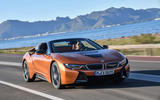We’ve waited a long time for the BMW i8 Roadster.
First previewed at the Beijing motor show as the i8 Concept Spyder in 2012, it’s taken a full six years for the plug-in hybrid open-top to be offered in the UK. In that time, the car has undergone a significant amount of development. But, despite the long gestation, it hasn’t lost any of its original impact.
Its contemporary exterior design and advanced powertrain specification might be familiar, coming some three years after the launch of the i8 Coupé, but there are few cars at any price that can claim to make such a powerful visual and technical statement as this roadster.
If anything, the i8’s futuristic lines are further enhanced by the loss of its roof, most notably around the rear, which has gained added prominence on the roadster due to the appearance of two large buttresses in the place taken up by the liftback-style tailgate on the coupé.
What else has changed beyond the removable roof?
The roof, which consists of a large fabric panel and integrated header rails, opens automatically in 15 seconds at speeds up to 31mph. It boats near-silent full electric operation and stows vertically behind the two-seat cabin at the press of a button, nestling in a space-saving position between the rear bulkhead and mid-rear mounted combustion engine.



































































